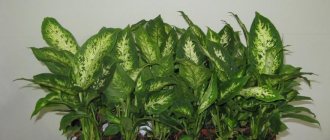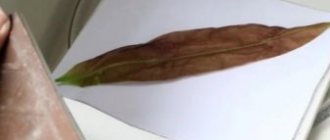Cyclamen is also called alpine violet and dryberry. It has an unpretentious character and pleases with wonderful flowers. The juice of the plant is used in traditional medicine recipes and pharmaceutical preparations, mainly related to the treatment of ENT diseases.
It has soothing, anti-inflammatory and antiseptic properties. It is destructive for most microorganisms, destroys viruses that provoke the development of colds, frontal sinuses, migraines, and inflammation of the maxillary sinuses.
Important : uncontrolled use of cyclamen extract for health purposes is dangerous.
The following varieties are most often found on window sills: Adjarian, European, Persian. There are about 20 species of perennials in the genus. They require an unpretentious attitude, which is why they are especially popular.
Adaptation
If the next day after appearing in a new home, purchasing it or receiving it as a gift, the cyclamen drops its leaves and flowers, do not panic and make unnecessary efforts aimed at “awakening” the plant. This is a natural behavior caused by stress due to a change in habitat. You need to wait some time for adaptation to take place. It is enough to provide only the appropriate conditions:
- The place should be cool and well lit by scattered rays of the sun.
- If the substrate is dry, you should slightly moisten the soil using bottom watering through a tray.
There is no need to feed for the first couple of months - it is not known when fertilizers were applied and whether this happened. Alpine violet purchased in a store will be accurately seasoned with a mineral complex.
Bud formation
Cyclamen begins to bloom after its dormant period ends (from the very beginning of June to September), and this happens gradually. From September to November, the plant “wakes up”: new green leaves begin to appear on it. And in December, when it has returned to the state it was in before hibernation, the plant finally begins to bloom: bright and variegated flowers grow on the peduncle, which do not fall off until the beginning of May.
Under all conditions created for the correct dormant period, cyclamen will bloom regularly.
How to care for alpine violet
For optimal well-being and rapid development, the home cyclamen flower needs natural living conditions.
Lighting
For permanent habitat, eastern and western windows are best suited in summer, and southern ones in winter. Cyclamen needs good and stable lighting. But you should avoid directed rays.
Watering
These bulbous plants will not appeal to every beginner, as they are very sensitive to high humidity in the soil mixture, and novice breeders often get carried away with watering.
During flowering, the soil should be irrigated when the surface of the soil dries out a little and this should be done from below: the pot with the plant is placed in a container with warm water for 15 minutes, and then raised, waiting for the excess to drain.
Important : if the liquid gets on a tuber or leaves, it will most likely cause a fungal disease and, as a result, death.
As a last resort, you need to water with a thin stream of settled water along the edge, right at the edge of the pot, so that moisture does not get on the cyclamen. After an hour, the excess is drained from the pan. Flowering lasts up to 4 months. Depending on the variety and living conditions - from October to March.
After flowering, the frequency of watering is reduced. By summer, all the leaves turn yellow and dry out, and the remaining tuber is rarely watered.
Like orchids, dry grasses tolerate dry soil more easily than flooded soil, but they will not survive long-term thirst.
Humidity
High humidity is harmful to cyclamen. Only during the heating season will you have to ensure that the indicator does not fall below normal and fluctuates between 40 and 50%.
Optimal temperature
The mother variety of the plant prefers coolness and partial shade. In summer, you can even bury it in the garden, where there is always shelter from the scorching sun, but do not forget about rain and seasonal thunderstorms.
The room temperature should be from +16 to +25°C, and in winter no higher than 14°C. Drafts should not be allowed; the plant may not survive rapid temperature changes.
How to trim
After it has finished flowering, you need to remove the flower stalks right down to the tuber. Forcibly cutting a plant to force it into hibernation is not recommended. It will begin to get sick often and will not live long.
The soil
The most suitable soil mixture for optimal plant development will be slightly alkaline. Slightly acidic and neutral are also suitable.
The composition, referring to the mentioned Ph parameters, can be anything, but not compressible when dried, but porous. It is trivial to dig up soil in a flowerbed or in a park - it definitely means killing the plant.
It is better to look in stores for a special mixture for cyclamen, but there are also more complex alternatives.
Preparation of the composition at home:
- You should stock up on universal soil for flowering plants, perlite, coarse sand, and pine needles.
- The soil is pre-sterilized with a solution of potassium permanganate. The liquid should be pale pink: 2 g of powder per 10 liters of water.
- The sand is cleaned in a steam bath for 30 minutes.
- Only unrotted forest needles or from boron are suitable, otherwise they will rot. You can do without it, but natural living conditions determine its presence.
- The entire mixture is calcined in an oven to protect the flower from fungal diseases. Proportions: 4 tbsp. land, 1 tbsp. sand, 2 tbsp. turf and 0.5 tbsp. pine needles
It is preferable to place pebbles over the substrate: gravel, pebbles, granite. No more than 1 cm in diameter, otherwise the soil will be compressed.
How to fertilize
After a dormant period, for active growth of green mass, nitrogen-based mineral fertilizers are added every 2 weeks. Cyclamen have a good relationship with organic matter.
Important : if you overdo it with nitrogen, there is a high probability that the tuber will rot.
Are there varieties of spathiphyllum that bloom with green flowers?
In addition to a long spadix, the spathiphyllum plant also has a bract - a “spread”. Brightly colored bedspreads can have different shades. Changing color to green is often a cause of concern even for experienced gardeners. There are several reasons for this
It is important to understand: why do spathiphyllum flowers appear green, what to do?
Spathiphyllum flower
The spathiphyllum plant is represented by a wide variety of varieties. The most common ones found in flower shops are:
- Charming. It is distinguished by the shape of the leaf plate with the most clearly defined veins. The inflorescences are light green. Following the rules of care allows you to achieve year-round flowering.
- Abundantly flowering - the smallest representative of spathiphyllum. Capable of blooming throughout the year.
- Chopin has been the most popular subtype for many years. The plant is able to absorb harmful air and saturate the environment with oxygen. The perianth is white and has a green edge. The flower plate is painted white.
- A rare representative of the species is the Picasso variety, which is one of the brightest spathiphyllums.
Abundantly flowering variety
On a note! In some varieties, greening of flowers occurs “with age.” For example, in the variety Helikonyelistny.
Flower transplant
It is better not to move cyclamen to a new pot unless absolutely necessary. Cases when this cannot be avoided: if the plant has grown and is cramped, during reproduction, or when the substrate is depleted. The size of the pot is determined depending on the age of the specimen. For a one-year-old flower, a container with a diameter of 7 cm will be enough, for a two-year-old - 14 cm. It all depends on the size of the bulb. There should be 2-3 cm from it to the edge.
Important : if you sharply increase the size of the pot, the soil may oxidize, which is harmful for the bulb. To avoid waterlogging of the earthen mixture, holes must be made in the bottom for drainage, if they were not provided initially.
The sequence of actions is as follows:
- A system for draining excess water is placed at the bottom of the pot - pebbles or expanded clay with a layer of 2 cm. Improper drainage can cause stagnation of liquid and death of the plant.
- Prepare the soil mixture.
- Remove the cyclamen from the old pot along with the soil.
- Clear the tuber from the soil, but not completely. Remove dried and soft rotten roots using a sterile knife or nail scissors.
- Place the tuber in the center of the pot.
- Gently straighten the roots so that they do not peek out.
- Cover with moistened soil.
- Water the dry wood moderately.
Injured healthy roots can cause the bulb not to take root.
Reproduction
Reproduction of cyclamen
Cyclamen is propagated by seeds, tuber division and division by daughter tubers.
The seed method is suitable for all types of indoor cyclamens.
Tuber division
Adult specimens are propagated in this way. After 7–8 years, many cyclamens lose their decorative properties and need rejuvenation. Divide the tuber in the dormant stage. It is removed from the ground and dried. It must be healthy and undamaged. Use a sharp knife to cut it into several pieces. Each division should have a bud and part of the roots. The sections are sprinkled with crushed charcoal and dried for 24 hours. Then the tubers are transplanted into separate pots with moist soil. The pots are placed in a shaded place and watered moderately to prevent rotting.
Division by daughter tubers
This propagation method is suitable for European cyclamen. Over time, small daughter nodules form around the mother tuber. They are easily separated from the main tuber when transplanted. They are planted in separate pots and cared for as young plants.
How to propagate cyclamen
This procedure is difficult to perform at home. If the owner is new to growing bulbs, it is better to undertake this with the assumption that it will not work out the first time, but you will gain some experience. Seedlings from seeds will germinate better, but will not bloom for a long time.
Tubers
Bulbs that have children or several growth points are suitable for propagation, which is extremely rare. You can divide the tuber, but this is dangerous for the mother plant. Therefore, the seed method is considered the only one possible at home.
Seeds
To obtain high-quality material, you should do pollination yourself. Crossing is best done between identical varieties, but this will require two copies. Using a soft brush, take a little pollen from the opened flower of one plant and apply it to the stigma of another.
Important : the procedure can be carried out with cyclamen alone, but it is unlikely that the manipulations will yield worthwhile results. For reliability, artificial pollination is repeated three times.
The best time is the morning of a clear day, which will have a beneficial effect on the formation of the ovary. It will not be superfluous to feed the alpine violet with phosphorus-potassium fertilizers during flowering. The resulting seeds are not dried, otherwise germination will decrease.
It is easier to buy seed at a garden store, but it is not always reliable due to long storage and, accordingly, low quality. In a word, this is not the easiest way to propagate a plant, but you can try.
Sequencing:
- Before sowing, the seeds are poured with a 5% sugar solution, and only those that have sunk to the bottom are sown.
- The selected material is soaked in a zircon solution.
- The primary substrate should be light: leaf soil with peat 1:1.
- The seeds are laid out on the soil mixture and sprinkled with a thin layer. No need for light yet. To increase the likelihood of germination, a greenhouse effect is created using a film stretched over the edges of the pot.
- Place in a shaded place and maintain a temperature of +20°C. In hot weather, the seeds will “fall asleep”, and in cold weather they will rot.
- Before the first sprouts, you should not allow the soil to dry out 2 cm. It should take up to 40 days.
- After this, remove the shading from the film and place the container on a windowsill with good lighting. The temperature in the room should not exceed +18°C.
- After the formation of tubers with 2-3 leaves (better if this happens in December), plant them in pots with soil recommended for the species.
- The first feeding is permissible after a week, but with a half dose. It blooms after a year and a half.
Choosing the right soil
To avoid problems associated with the development of the plant, it is necessary to select the correct soil before planting it. Cyclamen is a rather capricious flower, so only a properly selected substrate will promote its vigorous growth and flowering.
Today you can find any ready-made soil in specialized flower shops. Most amateur gardeners prefer ready-made soils, since in the store, among a large assortment of substrates, it is easier to choose one suitable for cyclamen. But if you wish, you can prepare it yourself from the following components:
- sand;
- peat;
- humus;
- turf land.
All components for the soil are used in the ratio 1:1:1:3.
Cyclamen: diseases and pests
The worst enemies include insects and mold. Viruses and most bacteria, due to the properties of the juice, are too tough for the plant.
Important : chronic waterlogging of the soil leads to death, and dry air and the top layer of soil will attract insects.
It's more difficult with rot. It can provoke various diseases, depending on the accompanying factors and the main pathogen.
Spider mite
Insects in the initial stages of infection are easy to control. The main thing is not to delay and start processing right away.
Treatment: just quarantine the plant and spray it with a solution of laundry soap, and repeat the procedure a week later for prevention. Affected leaves and flowers must be removed.
Aphid
The insect feeds on the sap of the plant. It stops growing and throwing out new shoots. This pest loves buds and large leaves most of all. It looks like white or gray dandruff, and unopened flowers are deformed.
Treatment: wash off the insects with a swab soaked in insecticide and spray again with the same preparation. After half an hour, rinse the plant under low pressure with a warm shower.
Thrips
Adults reach a length of 2 mm and are similar in shape to a spindle. They are clearly visible on the leaves because they are light in color. They leave behind a shiny silvery stream showing the direction of movement. They reproduce slowly - they grow from the egg stage to a mature individual within a month. If you notice in time the leaves covered with light spots and stripes, the stopped growth of the bush and deformed flowers can be saved.
Treatment: An insecticide is used to get rid of thrips. To prevent insect attacks, the air must be humidified to the required extent, and trap tapes for flying pests also help, since parasites enter the house from an open window.
Shchitovka
One of the most dangerous insect species for the alpine violet. It’s difficult to get rid of with chemicals—a simple insecticide won’t help. Adding to the complexity is that you can only notice the pest damage by seeing how the plant withers. To identify the enemy in time, you should inspect the stems and leaves weekly for small bumps and growths. This is the scale insect - each individual is covered on top with protection that protects it from the effects of the drug.
Treatment: The only option to try to save cyclamen is to remove the insects by hand.
Cyclamen mite
Microscopic oval pests with a transparent yellowish body and 4 pairs of legs. They can only be noticed with the naked eye when there is a large accumulation, and even then they look like a layer of dust. The leaves of the affected cyclamen curl and the buds fade.
Treatment: remove all damaged areas completely. Treat the remains of the bush with an insecticide.
Fusarium
A fungal disease that affects the vascular system of the bulb and green tissue. In common parlance it is called “core rot” or “dry rot”.
Reason: the fungus that gets on the plant clogs the blood vessels and disrupts the basic functions of its life, while simultaneously releasing toxic substances. Infection most often occurs through the soil, which is why the soil before planting is always treated by calcination in the oven.
Symptoms: leaves turn yellow at the tops, sometimes only on one side. The general condition gradually worsens if the disease has reached the core of the tuber. In the section of the bulb, numerous affected areas in the vascular bundles are visible.
Treatment: watering the root with Fundazol at a concentration of 0.1% and spraying the bush with Topsin-M 0.1%.
Wet rot
This is the most terrible disease for the alpine violet.
Reason: the causative agent is Erwinia, one of the few types of bacteria that can harm cyclamen. It enters through cracks and wounds on the tuber if it has been damaged or cut, but without appropriate disinfection treatment. And also through mechanical damage to vegetative organs at the cutting sites of peduncles and leaves. The source could be an infected neighbor on the windowsill or water.
Symptoms: the plant suddenly withers for no apparent reason. Leaves and flowers hang weakened. There is a bright putrid odor emanating from the tuber. It appears mainly in summer, in warm weather, when plants are kept outdoors or near a window with frequent ventilation of the room.
Treatment: There are no health measures. The plant must be destroyed so as not to spread the infection.
Gray rot
A threat to breeders who have many flowerpots nearby, or those who like to grow cyclamens in the garden.
Causes: it affects flowers that are weakened due to dense placement or an unfortunate location with damp and cold air. Improper watering and liquid getting into the growing point contribute to this.
Symptoms: traces of gray mold appear on the bush, which rises into the air when there is a strong gust of wind (with the window open). The affected areas die quickly, but the flowers first darken and the leaves turn yellow.
Treatment: The affected area is carefully removed. Increase ventilation in the room, but without a draft, which is dangerous for cyclamen. Minimize watering and treat with fungicide according to package instructions.
Root rot
The most common problem with cyclamens handled by beginners. Because of her, the plant began to be considered capricious.
Causes: caused by fungi that live in ordinary soil. Most often, a flower is affected by this disease due to the fact that it is planted in garden soil or soil that has not been steamed.
Symptoms: the disease attacks young specimens, significantly slowing growth. Leaves show signs of chlorophyll deficiency: they turn pale, become less elastic and beautiful. The damaged root system does not provide enough nutrition, which manifests itself in this way.
Treatment: spraying the substrate with a fungicide is not always effective, but it helps at the initial stage of damage. The disease spreads quickly, and young shoots are unlikely to be saved.
An adult flower must be removed from the pot, cleaned of soil, washed, removed dead roots, treated with a fungicide and planted in the correct mixture that has undergone special preparation and disinfection.
Sooty fungus
Aphids leave a sweetish secretion on the leaves, on which a black fungus forms. The insect itself cannot kill the plant, but waste products clog the stomata, covering the leaves from light.
Symptoms: growth slows down, the plates dry out, and the flower weakens.
Treatment: plaque is removed with a damp sponge soaked in a gentle solution of green soap and treated with a copper-soap mixture. Afterwards it is washed with clean water at room temperature and sprayed with fungicide.
The most common problems and their solutions
An unhealthy looking plant does not necessarily indicate disease. Cyclamen is sensitive to the environment in which it lives, and shows all the shortcomings with wilted stems and curled leaves.
Why do brown spots appear on leaves?
Dark areas or veins occur when the tuber is infected with fungus. Depending on the pathogen, the leaves may be further deformed. Most types of fungus, which are terrible for cyclamen and manifest themselves in this way, can be treated with fungicidal substances, which are sold in gardening stores.
Why do the leaves turn yellow?
If the watering plan is followed, then most likely the plant is hot. Humidifying the air will help. You need to make sure that the sun's rays from the window are diffused and not directed.
When the branches, and not just the plates, begin to dry, it is necessary to move the alpine violet to a cooler place. Another option is that the bush has outgrown its pot and is cramped.
Why does a flower wither?
Most often occurs with European or Persian varieties. It is worth recalling that this plant may have a prolonged period of primary adaptation when moving to new conditions, which applies not only to a house or apartment, but even to another window sill. Lethargy lasts up to a month and, if you follow the care procedure, the flower will invigorate.
Improper watering and some diseases cause the tree to wither. Attention should be paid to related factors. Prolonged lethargy is a reason to look at the bulb, the condition of which will accurately tell you about the true reason for the poor health of the bush.
Why doesn't cyclamen bloom?
Conditions that do not correspond to natural ones when grown at home can support the plant, but it will not produce flowers. Insufficient watering or waterlogging, dry air, a deficiency of minerals in the soil, or improper soil in the pot - all this can prevent the cyclamen from blooming.
It is worth remembering that young individuals begin to shoot arrows with buds only 1.5 years after sowing.
The leaves are curling
This is the first sign of improper care or transplanting into a pot that is unsuitable in size. The problem arises when clay is added to the soil or the new substrate turns out to be highly acidic. If the leaves begin to curl, this is the “first sign” that not everything is all right with the plant.
To prevent this from happening, you should carefully study the preferences of cyclamen and the conditions of its natural habitat, and then reproduce them with extreme accuracy.
The leaf may curl due to directed sunlight. Most of the green mass with this symptom indicates a lack of nutrients.
The leaves are rotting
This is due to increased soil moisture, frequent spraying, which is contraindicated for hybrid varieties, and fungal diseases. The main cause is determined by the method of exclusion based on associated symptoms.
Why does it drop buds?
Flowering occurs in late autumn, winter and early spring. Lasts from 3 to 4 months. During this period, the plant reacts sharply to direct sunlight, incorrect temperature and dry air. If the cyclamen is on the windowsill, in winter it should be placed away from the radiator.
The duration of flowering and the health of the buds are influenced by air temperature and the presence of necessary minerals in the soil. A blooming alpine violet sprayed from a spray bottle will immediately shed some of its buds.
Cyclamen is called a capricious plant by beginners who find it difficult to maintain the necessary conditions, and by those who cannot pay much attention to it. For experienced flower growers, it will be a wonderful home decoration and a useful source of healing juice.
Why are there no flowers at home?
It happens that after the cyclamen has faded, the owner waits in vain for the buds to appear again (read about the characteristics of cyclamen flowering and how to care for the plant before and after it has bloomed). This phenomenon can continue for more than one year.
If your flower does not bloom on time, there may be several reasons for this:
- It is hot in the room where the flower is located. At elevated temperatures it cannot produce color. The optimal temperature for flowering is 10 - 15 degrees.
- The root system is located at great depth. Accordingly, part of the stem is immersed in the ground. This also causes the plant to go dormant.
- Plant disease.











